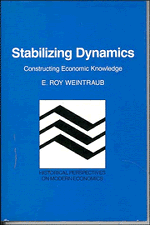7 - Surveying dynamics
from Part II - From history to interpretation
Published online by Cambridge University Press: 04 August 2010
Summary
The state of the economy, for instance, cannot be used unproblematically to explain science, because it itself is a very controversial outcome of another soft science, economics. As we saw earlier, it is extracted out of hundreds of statistical institutions, questionnaires, polls and surveys, and treated in centers of calculation. Something like the Gross National Product is an n the order visual display which, to be sure, may be combined to other paper forms, but which is no more outside the frail and tiny networks built by economists than stars, electrons, or plate tectonics.
Bruno Latour (1987, p. 256)In the period following the publication of Samuelson's articles on stability and equilibrium, a period that included the 1940s, the literature concerned with economic dynamics permeated several different subliteratures, one being that on the microfoundations of macroeconomics, which I have discussed elsewhere (Weintraub 1979). A second subliterature was that of endogenous business cycles, which attempted to trace out the time paths of economic variables. By the late 1950s and early 1960s that work had been linked to the 1930s literature on capital theory, as well as classical writings, thereby creating the modern literature on growth theory. In a third grouping, the writings were more directly concerned with understanding the implications of modeling economic systems, usually multi-market systems, as dynamic systems in the sense in which Samuelson had brought the term into common use in the economics literature; those contributions are now read as concerning the problem of the stability of the competitive equilibrium.
- Type
- Chapter
- Information
- Stabilizing DynamicsConstructing Economic Knowledge, pp. 128 - 148Publisher: Cambridge University PressPrint publication year: 1991

